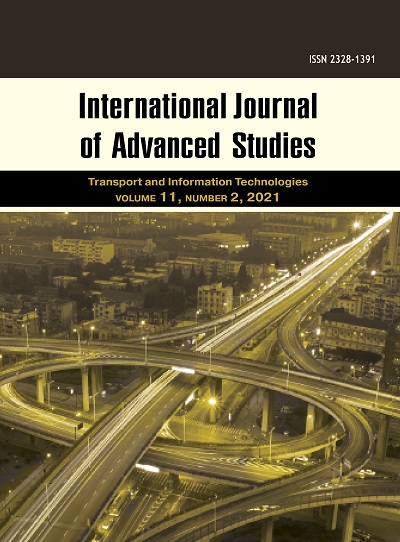МАТЕМАТИЧЕСКАЯ МОДЕЛЬ ЗАДАЧИ ЛОГИСТИКИ С ПЕРЕМЕННЫМ ТАРИФОМ
Аннотация
Логистика как наука и как сфера практических знаний вызывает в последнее время все более возрастающий интерес, так как ее деятельность многогранна. Логистика включает управление транспортом, складским хозяйством, запасами, кадрами, организацию информационных систем, коммерческую деятельность и многое другое. При этом наблюдается новизна подхода в логистике – органичная взаимосвязь, интеграция вышеперечисленных областей в единое управление материальными потоками. Транспортная логистика относится к основным разделам логистики движения ресурсов. Транспортная логистика позволяет на научной основе решать множество разнообразных задач различной сложности и масштабов.
В статье рассматривается математическая модель логистической задачи с переменными тарифами перевозок. Приведены численные решения математической модели симметричным алгоритмом, на основе усреднения переменных тарифов. Рассмотрены способы снижения затрат на перевозки.
Автоматизация информационных потоков, сопровождающих грузовые потоки, это один из наиболее существенных технических компонентов логистики. Использование методов логистики открывает новые резервы создания конкурентного преимущества той или иной фирмы на основе максимального удовлетворения запросов клиентов.
Цель – нахождение минимального пути методом симметричного алгоритма; исследовать эффективность расположения склада.
Метод или методология проведения работы: в статье использовались методы решения транспортной задачи, элементы теории графов, элементы теории нечетких множеств.
Результаты: проведено исследование на эффективность расположения склада, методом симметричного алгоритма был найден минимальный путь; оценена стоимость вводимых мер.
Область применения результатов: полученные результаты целесообразно применять при управлении транспортными перевозками, управлении потоками ресурсов (склады).
Скачивания
Литература
Agapova E.G., Popova T.M. Imitatsionnaya model’ uchastka transportnoy seti [Simulation model of a section of the transport network]. International Journal of Advanced Studies, 2020, vol. 10, no. 4,
pp. 139-144.
Agapova E.G., Popova T.M. Razrabotka imitatsionnoy modeli uchastka trans-portnoy seti v GPSS STUDIO [Development of a simulation model of a section of the transport network in GPSS STUDIO]. International Journal of Advanced Studies, 2020, vol. 10, no. 4,
pp. 145-151.
Golik T.V., Popova T.M. Modelirovanie logisticheskikh zadach [Modeling logistics tasks]. TOGU-start: fundamental’nye i prikladnye issledovaniya molodykh Mate-rialy nauchno-prakticheskoy konferentsii [TOGU-start: fundamental and applied research of young people Materials of the scientific-practical conference]. Khabarovsk, 2020, pp. 60-64.
Zak Yu.A. Fuzzy – regressionnye modeli prognozirovaniya zatrat vremeni i stoimosti gruzovykh avtomobil’nykh perevozok [Fuzzy - regression models for forecasting the time and cost of freight road transport]. Logistika segodnya, 2015, no. 3, pp. 162-172.
Zak Yu. A. Kriterii i metody sravneniya nechetkikh mnozhestv [Criteria and methods for comparing fuzzy sets]. Sistemnye issledovaniya i informatsionnye tekhnologii, 2013, no. 3, pp. 58-68.
Zak Yu. A. Prinyatie resheniy v usloviyakh nechetkikh i razmytykh dannykh: Fuzzy – tekhnologii [Making decisions in the face of fuzzy and blurry data: Fuzzy - technologies]. Moscow: Knizhnyy dom «LIBROKOM» Publ., 2013, 352 p.
Lukinskiy V.S., Berezhnoy V.I., Berezhnaya E.V. i dr. Logistika avtomo-bil’nogo transporta [Logistica of road transport]. Moscow, 2004, 368 p.
Vardomatskaya E.Yu., Sharstnev V.L., Aleekseeva Ya.A. Optimizatsiya marshruta s ispol’zovaniem teorii grafov v paketakh prikladnykh programm [Route optimization using graph theory in application packages]. Ekonomika, 2016, no. 1(30), pp. 130-139.
Orlovskiy S.A. Problemy prinyatiya resheniy pri nechetkoy informatsii [Decision-making problems with fuzzy information]. Moscow: Nauka, 1981, 264 p.
Pignastyy O.M. Stokhasticheskaya teoriya proizvodstvennykh system [Statistical theory of production systems]. Kharkov, 2007, 387 p.
Raskin L.G., Seraya O.V. Metod resheniya nechetkikh zadach matematicheskogo programmirovaniya [Method for solving fuzzy problems of mathematical programming]. Vostochno-Evropeyskiy zhurnal peredovykh tekhnologiy, 2016, no. 4(83), Vol. 5, pp. 23-28.
Tikhomirova A.N., Sidorenko E.V. Matematicheskie modeli i metody v logistike [Mathematical models and methods in logistics]. Moscow, 2010, 320 p.
Tyukhtina A.A. Matematicheskie modeli logistiki. Transportnaya zadacha [Mathematical models of logistics. Transport task]. Nizhny Novgorod, 2016, 66 p.
Ford M. Reshenie transportnoy zadachi [Solution of the transport problem]. Metody i algoritmy resheniya transportnoy zadachi [Methods and algorithms for solving the transport problem]. Moscow: Gosstatizdat, 1963, 72 p.
Yudin D. B. Matematicheskie metody upravleniya v usloviyakh nepolnoy in-formatsii. Zadachi i metody stokhasticheskogo programmirovaniya [Mathematical methods of control under conditions of incomplete information. Problems and methods of stochastic programming]. Moscow: Sov. radio, 1974, 392 p.
Bellman, R. E., and L. A. Zadeh. Decision-Making in a Fuzzy Environment. Management Science, 1970, vol. 17, no. 4, pp. B141–B164.
Grabara J., Kolcun M., Kot S. The role of information systems in transport logistics. International Journal of Education and Research, 2014, vol. 2, no. 2, pp. 1-8.
Lun Y. H. V. et al. Research in shipping and transport logistics. International Journal of Shipping and Transport Logistics, 2011, vol. 3, no. 1, pp. 1-5.
Szmidt E., Kacprzyk E. Distances between intuitionistic fuzzy sets. Fuzzy Sets and Systems, 2000, Vol. 114, no. 3, pp. 505–518. https://doi.org/10.1016/s0165-0114(98)00244-9
Yang M.-S., Lin T.-S. Fuzzy least-squares linear regression analysis for fuzzy input–output data. Fuzzy Sets and Systems, 2002, vol. 126, no. 3, pp. 389–399. https://doi.org/10.1016/s0165-114(01)00066-5
Просмотров аннотации: 369
Copyright (c) 2021 Elena G. Agapova, Tatyana M. Popova

Это произведение доступно по лицензии Creative Commons «Attribution-NonCommercial-NoDerivatives» («Атрибуция — Некоммерческое использование — Без производных произведений») 4.0 Всемирная.







































